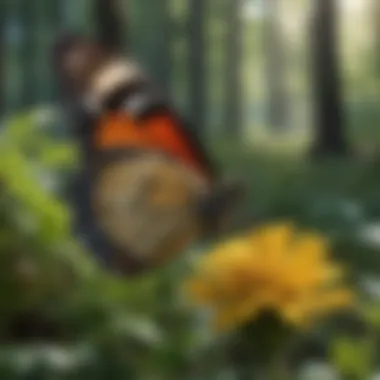Hampton Forest: Ecology, Biodiversity, and Preservation


Intro
Hampton Forest is a tapestry of life, intertwining biodiversity, climate regulation, and a sense of place that resonates deeply with its visitors. Its very essence speaks to those who wander its paths, evoking curiosity about the complex structures and systems sustaining it. As cities expand and urban areas encroach upon these vital green spaces, it's essential to delve into what makes Hampton Forest not just a sanctuary for wildlife, but a critical component of our urban ecosystem.
By unpacking its ecological significance and highlighting best practices for preservation and management, we can better comprehend the challenges it faces and the actions needed to protect it. The interaction between human activity and the forest's intricate web of life deserves close examination, providing insights for educators, nature enthusiasts, and forestry professionals seeking to deepen their understanding of this essential environment.
Understanding Woodland Ecosystems
Importance of Biodiversity in Forests
Biodiversity forms the backbone of an ecosystem, bringing life and resilience to forests. Each organism, from towering trees to tiny fungi, plays a role in maintaining the delicate balance of the ecosystem. Notably, Hampton Forest supports a myriad of species, acting as habitat for birds, insects, and mammals, many of which contribute to the forest's productivity.
- Nectar Producers: Various flowering plants attract pollinators, generating a cycle that sustains both plant and animal populations. For instance, the local wildflowers found here not only beautify the landscape but also provide sustenance for bees and butterflies.
- Decomposers: Fungi and microbes contribute by breaking down organic matter, returning nutrients to the soil and keeping it fertile.
- Trophic Levels: The interaction between predators and prey creates a balanced food web; each species contributes to the stability and health of the forest.
Role of Forests in Climate Regulation
Forests like Hampton play a pivotal role in regulating climate—covering both carbon sequestration and cooling urban heat. Trees absorb carbon dioxide, mitigating the effects of greenhouse gases, while their canopies provide shade that lowers surface temperatures, not only for the flora and fauna that rely on it but also for surrounding communities.
"A single mature tree can absorb CO2 at a rate of 48 pounds per year, providing enough oxygen for two human beings."
The forest acts as a carbon sink, potentially curbing climate change effects, showcasing the intrinsic connection between urban lifestyle and nature's tranquility.
Sustainable Forestry Practices
Principles of Sustainable Forestry
Sustainable forestry is the practice of managing forest resources in a way that meets current needs without compromising the forest’s health for future generations. In Hampton Forest, the emphasis is placed on:
- Maintenance of Ecosystem Health: Avoiding practices that lead to soil erosion, loss of species, or disruption of water cycles.
- Community Engagement: Involving local stakeholders in understanding and participating in forest management ensures a holistic approach to conservation.
Case Studies of Successful Implementations
Several successful programs have been implemented in urban forests akin to Hampton. These include:
- Comprehensive Urban Forest Management Plans: Cities like Portland, Oregon have adopted structured management frameworks, greatly enhancing their urban forest landscapes.
- Restoration Projects: Numerous restoration efforts focus on native plant species, such as those executed in the Greater Toronto Area, bringing back habitats to their natural states.
Woodland Stewardship Techniques
Forest Management Plans
Management plans serve as blueprints, guiding the stewardship efforts in forests. They are crucial for ensuring that activities undertaken have minimal impact on the ecosystem. Elements often included are:
- Monitoring and Research: Ongoing studies help understand forest dynamics and identify emerging threats.
- Public Education Programs: Workshops and community outreach efforts shine a spotlight on the importance of forest preservation.
Conservation Strategies
Conservation strategies might range from designated protected areas to active habitat restoration efforts. Implementing strategies can significantly enhance wildlife habitats while engaging local communities in stewardship. Examples may include:
- Buffer Zones: Establishing areas surrounding habitats to minimize human impact.
- Invasive Species Management: Identifying and controlling non-native species that disrupt the natural ecosystem.
With the right commitment from stakeholders and communities, Hampton Forest has the potential to thrive as a crucial urban oasis, reinforcing the fundamental relationships between people, wildlife, and the land that sustains them.
Hampton Forest Overview
The Hampton Forest stands as a vibrant testament to nature's resilience and complexity. This section explores the fundamental aspects like its geographical location and historical significance, both of which are crucial in understanding its ecological stature. The forest's role in local biodiversity, community culture, and environmental sustainability underscores its importance. By unraveling these threads, we see how the forest embodies a living archive of ecosystem dynamics, heritage, and the ongoing struggle between urban encroachment and conservation efforts.
Geographical Location
The natural terrain
The terrain in Hampton Forest is a captivating mosaic of rolling hills, sun-dappled clearings, and dense thickets. This variation enriches its biodiversity, offering a range of habitats that foster a multitude of plant and animal life. The unique topographical features, such as the gentle slopes and occasional outcroppings, facilitate water drainage while creating small microclimates that are beneficial for certain species to thrive. It acts as a natural buffer, absorbing excess rainfall which in turn controls flood risks in surrounding areas. This characteristic also minimizes noise pollution from adjacent urban areas, allowing wildlife to thrive in a quieter setting. Such aspects highlight why this terrain is not just mere soil and vegetation, but rather a lifeline for many organisms and a critical aspect of the local environment.
Nearby water bodies
Close proximity to rivers and streams significantly contributes to the ecological balance of Hampton Forest. These water bodies, be it the winding Harrison River or the smaller Silver Creek, serve as vital arteries for wildlife, providing drinking sources, breeding grounds, and habitats for aquatic species. They are also key players in nutrient cycling within the forest. However, its location poses a double-edged sword; while it enhances biodiversity, the water bodies are susceptible to pollution due to urban runoff, threatening the delicate ecosystem balance. This aspect draws attention to the intertwined fate of human activity and natural resources, making it a lively yet precarious subject, especially in discussions about conservation.
Surrounding urban areas
Urbanization plays a significant role in shaping the immediate context of Hampton Forest. It is nestled among thriving communities and bustling streets, which can impact it in several ways. The forest acts as a green lung, providing clean air and recreational opportunities for locals. This closeness not only increases public interest in conservation efforts but also highlights the stark difference between urban life and the tranquility of the woods. Still, the encroachment of urban sprawl raises concerns about habitat loss and fragmentation, prompting discussions on the need for sustainable urban planning that protects such vital ecosystems. The juxtaposition of urban life against the backdrop of the forest serves as a focal point for conservation advocacy, emphasizing that collaboration between nature and city dwellers is not merely an ideal but a necessity.
Historical Significance
Early settlement patterns
Hampton Forest has witnessed a rich tapestry of human interaction over the centuries. Early settlers relied heavily on its resources, forging a connection that was both respectful and utilitarian. The patterns of settlement show how communities shaped their livelihoods around the forest, utilizing timber, berries, and medicinal plants for their survival. This historical reliance underscores the important balance of using but also preserving natural resources. As time marched on, these methods evolved, sometimes leading to unsustainable practices, which now serve as cautionary tales in the history of environmental stewardship.


Traditional uses of forest resources
The forest's resources provided more than just physical sustenance; they were woven into the cultural fabric of local traditions. Many indigenous cultures practiced sustainable harvesting, understanding the significance of maintaining the health of the forest. Today, these traditional practices are being revived in various forms, illustrating that knowledge from the past can inform modern approaches to ecological conservation. Recognizing these traditional uses allows contemporary societies to appreciate local history and perhaps rethink resource utilization, making it a pivotal area of focus for those invested in ecological sciences.
Cultural significance in local history
The cultural significance of Hampton Forest cannot be overstated. Not only has it served as providers of materials, but it also stands as a symbol of resilience for communities throughout history. Local legends and stories circulated through generations often root themselves in the forest, intertwining community identity with the natural landscape. This cultural connection fosters a sense of belonging among residents, instilling a respect and reverence for the environment that is crucial for today's conservation efforts. By understanding these layers of historical significance, we can better appreciate how interconnected human narratives are with the landscapes that cradle them.
Ecological Characteristics
In examining Hampton Forest, the ecological characteristics provide a vital lens through which we understand its significance. The importance of this section lies in recognizing the myriad elements that contribute to the forest’s resilience and functionality. The sheer variety of life forms and processes embedded in the ecosystem underscores a relationship that is intricate and delicate. By paying attention to these characteristics, we can appreciate how they support not just the forest itself, but also surrounding communities and broader environmental systems.
Biodiversity of Hampton Forest
Plant species diversity
Plant species diversity within Hampton Forest is a marvel of nature, showcasing a wide array of flora that plays a key role in the overall health of the ecosystem. The variety of plant life contributes directly to the habitat's complexity, providing necessary resources for wildlife and stabilizing soil. A notable characteristic is the presence of both native and non-native species, each offering unique advantages and challenges. Native plants often co-evolve with local fauna, creating symbiotic relationships that promote biodiversity. For instance, oak trees not only offer shade but also serve as food and shelter for numerous species. On the flip side, non-native species can sometimes outcompete natives, leading to a homogenous plant structure that diminishes the forest’s ecological resilience.
Wildlife habitat presence
The wildlife habitat in Hampton Forest is another crucial aspect of its ecological identity. It serves as a sanctuary for various animal species, some of which may be rare or threatened. The unique feature of this habitat is its stratification, allowing different species to utilize the forest in distinct ways. Birds, mammals, reptiles, and insects all find niches conducive to their survival—be it nesting sites in canopy trees or ground cover for smaller critters seeking refuge. The variety in habitat types supports a diverse community, creating a dynamic ecosystem. However, habitat fragmentation poses a significant disadvantage; when parts of the forest become isolated, it disrupts migration patterns and breeding opportunities, ultimately threatening the wildlife diversity.
Endangered species considerations
Endangered species considerations in Hampton Forest warrant close attention, especially given the prevailing threats from both natural and human influences. Certain species, such as the Eastern Box Turtle, are indicators of ecosystem health, and their presence can signal underlying ecological issues. A critical characteristic here is the importance of conservation efforts—protecting these species not only safeguards their survival but also plays a role in preserving the entire forest ecosystem. The unique feature involves the interconnectedness of species; the disappearance of one can lead to unpredictable changes in the food web. Addressing the challenges faced by these species is beneficial for creating robust management strategies that ensure the longevity of Hampton Forest.
Ecosystem Functions
Carbon sequestration
Carbon sequestration is a fundamental ecosystem function of Hampton Forest, contributing significantly to climate change mitigation efforts. Trees act as carbon sinks, absorbing CO2 from the atmosphere and storing it in their biomass. A key characteristic of this function is its long-term effect; mature trees can sequester substantial amounts of carbon over decades. This makes them a crucial component in addressing global warming. However, as urban pressures increase, the forest’s capacity for carbon storage may be compromised, which emphasizes the need for sustainable management practices.
Soil health and erosion control
Soil health and erosion control are interconnected functions that highlight the importance of vegetation cover in Hampton Forest. The extensive root systems of trees and understory plants help anchor the soil, preventing erosion and promoting nutrient cycling. A beneficial aspect is that healthy soil contributes to the overall fertility of the forest, allowing for greater plant diversity. Conversely, when soil erosion occurs, it can lead to a loss of topsoil, reducing the land's capacity to support life. This can trigger a cascade of ecological consequences that undermine the forest’s integrity.
Water filtration processes
Water filtration processes take place within Hampton Forest, showcasing another critical ecological function. The forest acts as a natural filter for rainwater, with vegetation and soil absorbing pollutants and excess nutrients. A notable characteristic of this process is its dual benefit: it enhances water quality for local waterways and reduces flooding risks. However, the unique feature here lies in how development and land-use changes can compromise these filtration capabilities. If the forest is encroached upon or fragmented, its ability to perform this vital service diminishes, affecting both ecosystems and human populations.
"The ecological functions of forested areas not only support the health of these systems but also provide invaluable services to human communities in the surrounding areas."
Through understanding these ecological characteristics, it becomes evident how closely linked the health of Hampton Forest is to broader environmental and social frameworks. This depth of insight helps frame the conversation around conservation, management, and the sustainable future of this vital ecosystem.
Threats to Hampton Forest
Hampton Forest, while rich in biodiversity and ecological value, faces a multitude of threats that jeopardize its vitality. Understanding these threats is crucial not only for the conservation of this forest but for the broader environmental health of the region. Two key areas of concern involve urbanization and climate change, both of which have profound impacts on the delicate balance of forest ecosystems. Addressing these challenges requires a thorough grasp of their nature and implications.
Urbanization Impact
Urbanization poses significant challenges to Hampton Forest, disrupting the natural landscape and altering ecological functions in various ways.
Land use change
Land use change refers to the transformation of natural landscapes into urban areas, agricultural lands, or industrial sites. This shift dramatically impacts the forest's structure and health. One major characteristic of land use change is the conversion of green spaces into residential neighborhoods. This phenomenon not only reduces the available habitat for wildlife but also fragments ecosystems, making it harder for species to thrive.
Additionally, urban sprawl often leads to increased pollution and runoff, which can degrade soil and water quality within the forest. The loss of trees also means less carbon sequestration, undermining efforts to combat climate change. While land use conversion may promise economic gains for urban developers, it poses long-term disadvantages for ecological sustainability.
Fragmentation of habitats
Fragmentation of habitats results when expansive forest land is cut into smaller, isolated patches due to urban development. This can severely compromise local biodiversity. A key aspect of fragmentation is the creation of barriers such as roads or buildings that inhibit animal movement. Many species depend on large territories for foraging and mating, and when those territories are split apart, their chances of survival diminish.
The unique aspect of habitat fragmentation is its cumulative effect. Once-populated areas become eerily quiet as plants and animals disappear, leaving behind echoes of what once thrived. The downsides are manifold: reduced genetic diversity, increased competition among species, and a higher vulnerability to invasive species – all contributing to a declining ecosystem.
Invasive species introduction
Invasive species introduction refers to non-native plants or animals being introduced into the forest, often through human activity. These species can upset the delicate balance of native ecosystems by outcompeting local flora and fauna for resources. One distinctive feature of invasive species is their rapid growth and reproduction rates, which allow them to dominate ecosystems quickly.
The consequences of such introductions can be dire. Invasive species can disrupt food webs, leading to a decline in native species populations. This disruption diminishes the forest's ecological integrity and resilience. Furthermore, controlling invasive species often requires significant resources and effort. The battle against them can thus seem unending, underscoring the importance of proactive measures to prevent their introduction in the first place.
Climate Change Effects
Climate change presents another layer of threat to Hampton Forest, reshaping the landscape in ways that are not always immediately apparent but deeply felt.
Altered growth patterns


Altered growth patterns in plants and trees are increasingly noticeable as climate shifts occur. Changes in temperature and precipitation significantly influence when and how trees grow. For instance, earlier springs can result in trees leafing out sooner but may also lead to a mismatch with the timing of pollinators. A key characteristic of these altered growth patterns is that they can disrupt the entire forest's phenology.
The consequence of altered growth can be varied. Some species may thrive under the new conditions, while others may struggle, potentially leading to shifts in species composition that affect overall biodiversity. It raises questions about what trees will dominate in the future and whether this will lead to a decline in overall forest health.
Threatened species survival
With climate change, many species in Hampton Forest are facing threats to their very existence. Species survival hinges on their ability to adapt to changing conditions, and this adaptability is not uniform across the board. A highlight of this issue is that some species may not be able to keep pace with the speed of climate changes, leading to localized extinctions. The unique feature of this problem is its systemic nature; the survival of one species can hinge on the health of others, creating a domino effect that threatens the entire ecosystem.
The implications of threatened species are clear: biodiversity loss reduces the forest's resilience to future challenges and undermines the ecological services that diverse ecosystems provide, such as water filtration and carbon storage.
Impact on ecosystem services
Ecosystem services refer to the benefits that natural environments provide to human beings and other living organisms. These services include clean air and water, pollination, and climate regulation. Climate change exacerbates the deterioration of these services in Hampton Forest. A key characteristic of ecosystem services is their interconnectedness; the decline of one service cascades into others.
The impact on these services can be insidious. For instance, forests experiencing stress due to climate shifts might not sequester carbon as effectively or provide clean water filtration, which can increase the burden on other ecosystems as they try to compensate. The unique feature here is the potential for feedback loops; as ecosystem services decline, it can further contribute to climate change's adverse effects, creating a vicious cycle that's hard to break.
"Understanding the threats to Hampton Forest is not just a matter of detecting problems but envisioning solutions for a healthier future."
The wellbeing of Hampton Forest is a delicate thread that merits the collective attention of conservationists, urban planners, and the community.
Management and Conservation Strategies
Management and conservation strategies play a critical role in ensuring the longevity and ecological integrity of Hampton Forest. The forests are not just a collection of trees, but rather a complex web of life that underpin the local ecosystem's health. Effective management reflects an understanding of the delicate balance between human impact and natural processes. By fostering a collaborative approach that includes both scientific knowledge and community engagement, these strategies can help mitigate threats while enhancing biodiversity and overall forest health.
Sustainable Forestry Practices
Selective logging
Selective logging is a forestry practice that carefully removes certain trees while leaving others intact. This method aims to minimize environmental disruption while allowing for the sustainable extraction of wood resources. One of the key characteristics of selective logging is its ability to maintain canopy cover, which supports a more stable microclimate beneath the trees. This practice is especially beneficial because it reduces soil erosion and allows for natural regeneration of the forest, making it a popular choice in Hampton Forest. Furthermore, selective logging can create habitat diversity, providing spaces for varying wildlife needs, thus supporting the overall ecological goal of forest sustainability.
However, selective logging does come with its unique challenges. If not managed correctly, it can inadvertently lead to over-harvesting or damage to surrounding trees, which can have cascading effects on forest dynamics.
Forest restoration techniques
Forest restoration techniques focus on rejuvenating degraded areas of the forest. Restoration may involve a range of actions, from reintroducing native species to the area to improving soil health. One prominent aspect of these techniques is the use of ecological practices that promote self-sustainability for the forest ecosystem. This is crucial because a thriving forest can better withstand environmental pressures such as climate change and invasive species.
The beauty of restoration techniques lies in their adaptability. They can be tailored to specific areas within Hampton Forest, addressing varied challenges presented by past mismanagement or natural disturbances. The downside might be the time and resources required for successful implementation. But, as seen in many projects, the long-term ecological benefits far outweigh these initial investments.
Native species replanting
Native species replanting involves sowing indigenous plants back into their natural habitats, promoting ecological resilience. This practice can significantly boost local wildlife by providing them with food and habitat that they have evolved to depend on. One of the most compelling aspects of native species replanting is its potential to enhance genetic diversity within the forest. Keeping the planting efforts focused on native varieties prevents the introduction of invasive species that could disrupt existing ecosystems, making it a favorable approach in Hampton Forest.
Nonetheless, there can be limitations in terms of availability of native seeds or saplings. Furthermore, ensuring proper care and monitoring of newly planted species is vital for their integration into the existing ecosystem.
Community Involvement
Volunteer initiatives
Volunteer initiatives create an avenue for individuals in the community to actively participate in conservation efforts. This can range from tree planting to habitat restoration activities. A hallmark of these initiatives is that they foster a sense of ownership and responsibility towards the forest. When locals get their hands dirty and contribute to the work, they create lasting relationships with the land, which is essential for future conservation efforts.
However, while volunteer initiatives can yield enriching experiences, they may occasionally face challenges such as limited volunteer availability or varying skill levels, which can affect project outcomes.
Educational programs
Educational programs focus on fostering awareness about forest ecosystems among community members, particularly youth. These might include workshops, guided forest walks, or interactive learning sessions. Such initiatives help demystify the importance of sustainable practices and are integral in creating informed future stewards of the forest. One of the key characteristics of these programs is their versatility; they can adapt to groups of different ages and backgrounds, thus extending their reach significantly.
On the flip side, securing funding for continuous educational outreach can be a hurdle. Regular engagement is crucial to maintain interest over time, and without consistent support, organizing events might become sporadic.
Local partnerships
Forming local partnerships with schools, non-profits, and businesses can significantly amplify conservation efforts—a characteristic that holds considerable weight in Hampton Forest. Such collaborations often bring varied expertise and resources together, making initiatives stronger and more impactful. By merging the strengths of different stakeholders, partnerships can inspire innovative approaches to conservation challenges, enhancing the effectiveness of management strategies.
While the benefits are clear, coordinating among various organizations can introduce complexity. Ensuring smooth communication and a shared vision is fundamental for successful local partnerships in achieving conservation goals.
The Role of Education in Woodland Stewardship
Education is a cornerstone in promoting effective woodland stewardship. Understanding the essential dynamics of forest ecosystems within Hampton Forest is pivotal for sustainable management practices. Educators play a crucial role in demystifying complex ecological concepts for the younger generations, paving the way for informed future stewards of nature. It’s not just about planting trees; it’s about planting a seed of understanding that can grow and flourish over time.
By emphasizing the importance of woodland ecosystems, we can inspire a sense of responsibility toward the environment. From local schools to community programs, each initiative contributes to a broader educational framework that prepares individuals to engage meaningfully with their natural surroundings.
School Programs and Outreach
Field trips and outdoor learning
Field trips serve as a bridge between classroom learning and real-world experiences. By stepping into Hampton Forest, students get to witness the diverse plant and animal life up close. There's a unique characteristic of field trips: they stir curiosity in a way that textbooks simply can’t. This hands-on activity is essential because it fosters a deeper appreciation for nature and its intricate webs of life.


When students wander through the trees, they become more attuned to their environmental surroundings. Engaging with nature directly helps them understand concepts such as biodiversity and ecosystem health much better. However, one must consider that not all school trips can be seamlessly organized; logistical challenges can occasionally put a damper on these valuable experiences.
Workshops for educators
Workshops for educators aim to equip teachers with the necessary tools and knowledge to guide their students effectively. These gatherings emphasize current best practices in environmental education. One significant aspect of these workshops is the focus on integrating local ecological insights into the curriculum. It's a beneficial strategy, allowing educators to stand in the shoes of their students.
Moreover, teachers participating in these workshops are not only learning but also networking with local conservationists and forestry professionals. This unique collaboration can lead to improved educational resources and broadened perspectives within classrooms. Although these workshops are designed to be constructive, the challenge lies in maintaining ongoing support for educators after the training sessions end.
Engagement with youth organizations
Involving youth organizations in woodland stewardship initiatives can amplify education efforts. Many such groups focus on promoting environmental awareness among young people, providing them with hands-on activities that complement school curricula. One of the key characteristics of these organizations is their ability to foster teamwork.
Youth-focused initiatives often lead to community-led conservation projects that empower young people and instill a sense of belonging. While this interaction is primarily beneficial, there are challenges; ensuring active participation and retention can sometimes be tough in the face of competing interests.
Public Awareness Campaigns
Social media efforts
Social media serves as a modern megaphone for raising awareness about Hampton Forest. Through targeted campaigns and community posts, organizations can share information about the forest’s ecology and conservation needs in an engaging manner. A key characteristic of these efforts is their capacity to reach diverse audiences quickly, transcending geographic barriers.
These platforms allow stories and visuals to resonate deeply, effectively galvanizing public support for conservation. Yet, there is a caveat. The continuous nature of content creation can strain resources, often requiring substantial commitment from both time and personnel.
Informational signage in parks
Signage in parks plays an understated yet crucial role in educating visitors about the delicate ecosystems within Hampton Forest. Well-placed signs can peel back the layers of complex ecological processes and provide context for visitors’ experiences. The unique feature here is that these signs often serve as silent educators that engage people in an unobtrusive way.
While most signs effectively inform, there's potential for information overload if not done thoughtfully. Striking the right balance between detail and clarity is key, ensuring that visitors do not feel overwhelmed while still learning effectively.
Community events and festivals
Community events and festivals focused on nature and ecology create a platform for hands-on learning and engagement for all age groups. These events, such as tree planting days or wildlife workshops, serve as a vibrant celebration of local biodiversity. A primary characteristic is the inclusiveness of such activities; they are designed for every member of the community to participate.
However, it’s vital to recognize that organizing these events can require considerable time and finances, making it challenging for smaller organizations to sustain frequent activities. Nonetheless, when successful, they elevate the public's connection to and appreciation for the woodland environment.
The Future of Hampton Forest
Considering the trajectory of urbanization and environmental changes, the future of Hampton Forest holds considerable importance, both as a critical ecosystem and as an essential resource for local communities. Addressing this topic shines a light on several elements, including the integration of research and innovative practices, sustainable development, and the roles played by community and policymakers. The success of these efforts hinges on the collective understanding and involvement of stakeholders to craft a resilient future for this woodland gem.
Research and Innovation
Monitoring ecosystem changes
Monitoring ecosystem changes in Hampton Forest serves as a cornerstone for its long-term health and viability. This practice embodies a systematic approach that tracks biological diversity, climate impacts, and other critical metrics. A key characteristic of this monitoring is its adaptability; researchers can shift methodologies based on fluctuation in environmental conditions or species presence, ensuring timely data collection.
The ability to regularly assess biodiversity levels positions monitoring as a robust strategy to pinpoint areas requiring focused conservation efforts. One unique feature is the integration of citizen science, which encourages local residents to participate in data collection and can enhance community engagement. However, this approach faces challenges such as potential biases from public contributions and the need for thorough training to ensure accuracy.
New technologies in conservation
The introduction of new technologies in conservation has significantly advanced how Hampton Forest is managed. For instance, the use of drones empowers researchers to assess large areas quickly, providing aerial views that reveal changes in plant growth patterns or habitat disruptions. This innovation brings efficiency and thoroughness into the conservation toolbox, allowing a more proactive style of forest management.
One of the unique features of these technologies is their ability to collect real-time data, crucial for immediate response strategies. However, the reliance on technology may also introduce limits, especially in areas where connectivity is poor, hindering data transmission and analysis.
Long-term ecological studies
Long-term ecological studies present a wealth of insight into the dynamics at play within Hampton Forest. By observing changes over extended periods, researchers can identify trends that inform local environmental policy and conservation strategies. Such studies are vital for understanding species interactions and how environmental stressors affect various habitats.
A prominent characteristic of these studies is the comprehensive data archive they create, facilitating retrospective analysis and predictions about future trends. This feature allows for a deeper understanding of historical shifts in the ecosystem. But they can be resource-intensive, requiring sustained funding and commitment over many years, which might deter immediate action based on short-term crises.
Vision for Sustainable Development
Integrating urban planning with forestry needs
Integrating urban planning with forestry needs is fundamental for the future sustainability of Hampton Forest. Planning that acknowledges the ecosystem services provided by the forest can reduce conflicts between development and conservation goals. One key characteristic here is the collaborative approach among urban planners, environmentalists, and local government, which helps formulate policies that respect both ecological and community needs.
A notable feature of this integration includes green corridors – these natural pathways connect urban areas with forested regions, promoting biodiversity while offering recreation space for residents. However, balancing interests of developers with ecological preservation remains a complex issue.
Promoting sustainable tourism
Promoting sustainable tourism can bolster both the local economy and protective efforts for Hampton Forest. By attracting visitors interested in nature, educational programs, and eco-friendly practices, forest stewardship becomes more valuable. The essence of sustainable tourism lies in its ability to foster an appreciation of the forest's ecological roles while generating revenue that can fund conservation initiatives.
One beneficial aspect is that it can raise awareness about the importance of biodiversity and healthy ecosystems among visitors. Simultaneously, local businesses can thrive as they offer eco-tours and local food. On the downside, if not managed carefully, tourism can lead to overcrowding and strain on resources, jeopardizing the very environment it seeks to promote.
Future policy implications
Looking ahead, future policy implications will significantly impact the trajectory of Hampton Forest. Effective policies should embody both proactive conservation strategies and reactive measures responding to unforeseen changes. A major benefit of robust policy frameworks is their ability to guide investment, research, and community initiatives.
Policies focusing on adaptive management practices, for instance, create a flexible approach that can evolve as conditions change. A unique feature here is the potential for stakeholder engagement in the policymaking process, fostering a community sense of ownership over forest resources. However, implementation could be hindered by bureaucracy and varying levels of political will, posing a challenge for actionable change.
"The future of Hampton Forest lies not just in protecting what’s there but in understanding and adapting to the changes on the horizon."
In summary, the future of Hampton Forest will depend on a combination of research, innovative conservation technologies, sustainable development practices, and robust policies. For those invested in forest health and longevity, understanding these elements is crucial for shaping the paths forward.







